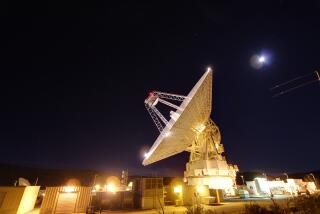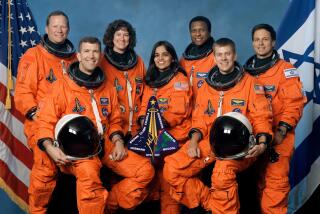NASA’s Continuing Problems
- Share via
Re: Gregg Easterbrook’s “NASA: What Goes Up; A Can-Do Agency Becomes a Can’t-Do Bureaucracy,” (Opinion, July 22):
While free criticism is a hallmark of our system, for The Times to publish an article where virtually every “point” is based on totally incorrect data is incredible. To wit:
1--Easterbrook states no NASA executives lost their positions as a result of Challenger and cites J.R. Thompson as his example stating Thompson was the director of the Marshall Center and therefore directly in charge of the solid rocket booster that failed.
Fact: At the time of the Challenger accident, Thompson was employed by Princeton University. The Marshall director was Dr. W. Lucas who had been in that position for more than a decade. Lucas resigned from NASA shortly after the accident, as did a large number of other executives in the Challenger’s chain of command.
Thompson was hired by NASA to replace Lucas in the rebuilding of its management structure in the Challenger aftermath. Thompson’s success at Marshall led to President Bush’s appointment of him to his current position.
2--Rogers Commission Reports Discarded. Fact: Today’s shuttle operations and management structure have incorporated virtually all of the Rogers recommendations.
3--No Expendable Launch Vehicles. Fact: With the commercialization initiatives NASA does not, nor should it produce mature expendable launcher. NASA and DOD routinely purchase launch service from several healthy American producers, i.e., Delta from McDonnell Douglas, Atlas from General Dynamics and Titan from Martin Marietta.
4--NASA Hates Spaceplane. Fact: NASA is an enthusiastic partner with the DOD in the prototype X-30 National Aerospace Plane (NASP). This craft is expected to be flying late in the decade. This technology has the potential to produce an operational spaceplane that would replace the shuttle fairly early in the next century. Note: The X-15 was not a spaceplane and had no capabilities to ever approach orbital conditions. It was an enormously successful high-speed research airplane that could briefly touch the lower reaches of space, however it was not without accidents.
The above are just samples of the inaccuracies pervasive in Easterbrook’s article. This is not to say NASA does not have problems. However, it also has a new, talented and highly motivated management structure that is aggressively addressing problems and issues to revitalize American space initiatives.
RAY TJULANDER
Resident Manager
Marshall Space Flight Center
Resident Management Office
Canoga Park
More to Read
Sign up for Essential California
The most important California stories and recommendations in your inbox every morning.
You may occasionally receive promotional content from the Los Angeles Times.










